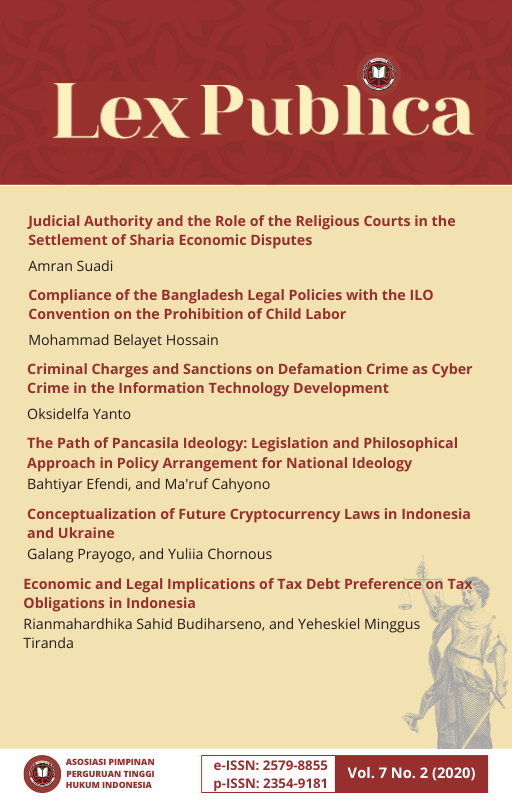Compliance of the Bangladesh Legal Policies with the ILO Convention on the Prohibition of Child Labor
DOI:
https://doi.org/10.58829/lp.7.2.2020.15-23Keywords:
Legal Policy, Labor, Child Labor, ILO Convention, BangladeshAbstract
This article aims to discuss the legal policy framework in Bangladesh laws prohibiting child workers. The law has banned children from doing hazardous work, but does not define the term ‘dangerous work’. Article 44 of the 2006 Bangladesh Labor Act contradicts the 1973 ILO Minimum Age Convention. In most cases, multinational enterprises (MNEs) agents or supply chains employ children; but foreign investors also have the same responsibility to oversee the local operations of their counterparties. So, it is very important to ensure the protection of the human rights of child workers. Broadly speaking, the findings highlight the need for providing justice, legal certainty and human rights consideration in specifying worker rights such as education, fair wages, limited working hours, safe working conditions, and health protection which must be guaranteed through labor laws.
Abstrak
Artikel ini bertujuan untuk membahas kerangka kebijakan hukum dalam undang-undang Bangladesh dalam pelarangan pekerja anak. Undang-undang telah melarang anak-anak melakukan pekerjaan berbahaya; tetapi tidak mendefinisikan istilah 'pekerjaan berbahaya'. Pasal 44 Undang-Undang Ketenagakerjaan Bangladesh tahun 2006 bertentangan dengan Konvensi Usia Minimum ILO tahun 1973. Dalam kebanyakan kasus, agen atau rantai pasokan perusahaan multinasional (MNEs) mempekerjakan anak-anak; tetapi investor asing juga memiliki tanggung jawab yang sama untuk mengawasi operasi lokal rekanan mereka. Jadi, sangat penting untuk memastikan perlindungan hak asasi manusia pekerja anak. Secara garis besar, temuan tersebut menyoroti perlunya memberikan keadilan, kepastian hukum dan pertimbangan hak asasi manusia dalam menetapkan hak-hak pekerja seperti pendidikan, upah yang adil, jam kerja yang terbatas, kondisi kerja yang aman, dan perlindungan kesehatan yang harus dijamin melalui undang-undang ketenagakerjaan.
Kata kunci: Kebijakan Hukum, Perburuhan, Pekerja Anak, Konvensi ILO, Bangladesh
References
Afrin, Samina. “Labour Condition in the Apparel Industry of Bangladesh: Is Bangladesh Labour Law 2006 Enough?.” Development Country Studies 4, no. 11 (2014).
Ahonen, S. “New Bangladesh Minimum Wage.” Sustainability Agents (2018, December 18th). Accessed from https://sus-a.com/index.php/new-bangladesh-minimum-wage/2018/.
Bourdillon, Michael FC, Deborah Levison, Ben White, and William Myers. Rights and wrongs of children's work. Rutgers university press, 2010
International Labour Office. World employment and social outlook: Trends 2015. Geneva: International Labour Organization, 2015.
Islam, M. Zohuru, and Sununta Siengthai. “Quality of work life and organizational performance: Empirical evidence from Dhaka Export Processing Zone.” In ILO Conference on Regulating for Decent Work, Geneva, pp. 1-19. 2009.
Lamothe, Josianne, Amélie Couvrette, Gabrielle Lebrun, Gabrielle Yale-Soulière, Camille Roy, Stephane Guay, and Steve Geoffrion. “Violence against child protection workers: A study of workers’ experiences, attributions, and coping strategies.” Child abuse & neglect 81 (2018): 308-321.
Licht, Walter. “How the Workplace Has Changed in 75 Years-Dramatic Developments in the Economy, in Technology, and in the Labor, Force Have Required Changes in Working Conditions and Standards.” Monthly Lab. Rev. 111 (1988): 19.
Munshi, Farzana. “Do Minimum Wages Reduce Employment? Some Empirical Evidence from Bangladesh.” The Bangladesh Development Studies 41, no. 3 (2018): 57-72.
OHCHR. Convention on the Rights of the Child. 20 November 1989. Retrieved from https://www.ohchr.org/en/instruments-mechanisms/instruments/convention-rights-child.
Rashid, M. M., and Mohammad Ashrafur Rashid. “Health and Safety Environment of Readymade Garment Industry in Bangladesh: A Case Study of Zaheen Knitwears Limited.” Manarat International University Studies 4, no. 1 (2015): 71-82.
Rubya, Tamanna. “The ready-made garment industry: An analysis of Bangladesh's labor law provisions after the Savar Tragedy.” Brooklyn Journal of International Law 40, no. 2 (2015): 7.
Saha, Hillol, and Takmina Kamal. “Rights of the child worker of Bangladesh: An appraisal.” Asian Journal of Multidisciplinary Studies 6, no. 2 (2018): 85-92.
Shah, Nahid. “Determinants of foreign direct investment: A study on Bangladesh.” Journal of Economics and Sustainable Development 4, no. 18 (2013): 11-17.
Strolin, Jessica S., Mary McCarthy, and Jim Caringi. “Causes and effects of child welfare workforce turnover: Current state of knowledge and future directions.” Journal of Public Child Welfare 1, no. 2 (2006): 29-52
The Daily Star. “New pay structure for EPZ workers approved.” (Thu Dec 26, 2013). Retrieved from https://www.thedailystar.net/new-pay-structure-for-epz-workers-approved-3987.
Downloads
Published
How to Cite
Issue
Section
License
Copyright (c) 2022 Author(s)

This work is licensed under a Creative Commons Attribution 4.0 International License.








